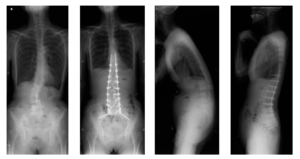Adolescent Idiopathic Scoliosis
2022年5月2日
最終更新日時 :
2024年11月8日
 webmaster
webmaster
I will provide information on surgical methods, length of hospital stay, insurance coverage, and related details for Adolescent Idiopathic Scoliosis.
Adolescent Idiopathic Scoliosis
Adolescent Idiopathic Scoliosis (AIS)
Adolescent Idiopathic Scoliosis (AIS) is a type of scoliosis that typically progresses from adolescence into young adulthood. Unlike adult spinal deformities that occur in middle-aged and older individuals, AIS involves minimal deformity of the bones and intervertebral discs, and it is characterized by flexible deformity.
Symptoms
It typically presents without symptoms such as pain and is often detected during school screenings. Brace therapy is usually recommended for Cobb angles of around 30 degrees, but when brace therapy proves ineffective or when the Cobb angle exceeds 40 degrees, surgery may become necessary. When the Cobb angle reaches approximately 60 degrees, it can potentially impact respiratory function, including lung capacity.
Treatment methods
Bones can be relatively easily measured, so if a decrease in bone density is observed, medications that increase bone density or strengthen bones may be administered. If compression fractures have already occurred, braces or casts may be used to alleviate pain and prevent spinal deformities. If appropriate treatment is not provided at the hospital, the bones may fail to heal properly, and pain may persist.
Surgical methods
Surgery involves correcting the deformity using screws inserted from the posterior approach in scoliosis surgery.

